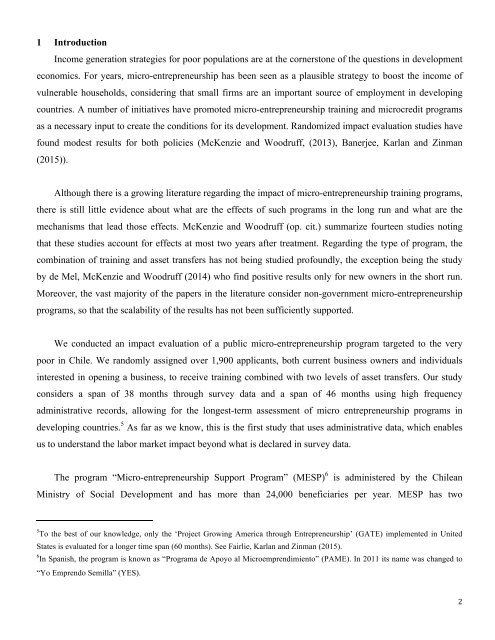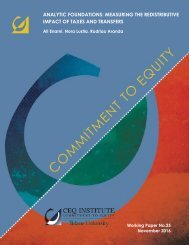DOCUMENTO
n?u=RePEc:ioe:doctra:461&r=lam
n?u=RePEc:ioe:doctra:461&r=lam
Create successful ePaper yourself
Turn your PDF publications into a flip-book with our unique Google optimized e-Paper software.
1 Introduction<br />
Income generation strategies for poor populations are at the cornerstone of the questions in development<br />
economics. For years, micro-entrepreneurship has been seen as a plausible strategy to boost the income of<br />
vulnerable households, considering that small firms are an important source of employment in developing<br />
countries. A number of initiatives have promoted micro-entrepreneurship training and microcredit programs<br />
as a necessary input to create the conditions for its development. Randomized impact evaluation studies have<br />
found modest results for both policies (McKenzie and Woodruff, (2013), Banerjee, Karlan and Zinman<br />
(2015)).<br />
Although there is a growing literature regarding the impact of micro-entrepreneurship training programs,<br />
there is still little evidence about what are the effects of such programs in the long run and what are the<br />
mechanisms that lead those effects. McKenzie and Woodruff (op. cit.) summarize fourteen studies noting<br />
that these studies account for effects at most two years after treatment. Regarding the type of program, the<br />
combination of training and asset transfers has not being studied profoundly, the exception being the study<br />
by de Mel, McKenzie and Woodruff (2014) who find positive results only for new owners in the short run.<br />
Moreover, the vast majority of the papers in the literature consider non-government micro-entrepreneurship<br />
programs, so that the scalability of the results has not been sufficiently supported.<br />
We conducted an impact evaluation of a public micro-entrepreneurship program targeted to the very<br />
poor in Chile. We randomly assigned over 1,900 applicants, both current business owners and individuals<br />
interested in opening a business, to receive training combined with two levels of asset transfers. Our study<br />
considers a span of 38 months through survey data and a span of 46 months using high frequency<br />
administrative records, allowing for the longest-term assessment of micro entrepreneurship programs in<br />
developing countries. 5 As far as we know, this is the first study that uses administrative data, which enables<br />
us to understand the labor market impact beyond what is declared in survey data.<br />
The program “Micro-entrepreneurship Support Program” (MESP) 6<br />
is administered by the Chilean<br />
Ministry of Social Development and has more than 24,000 beneficiaries per year. MESP has two<br />
5 To the best of our knowledge, only the ‘Project Growing America through Entrepreneurship’ (GATE) implemented in United<br />
States is evaluated for a longer time span (60 months). See Fairlie, Karlan and Zinman (2015).<br />
6 In Spanish, the program is known as “Programa de Apoyo al Microemprendimiento” (PAME). In 2011 its name was changed to<br />
“Yo Emprendo Semilla” (YES).<br />
2



